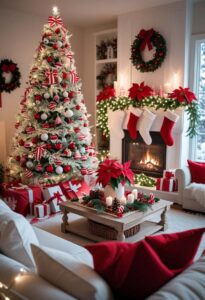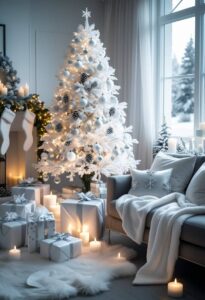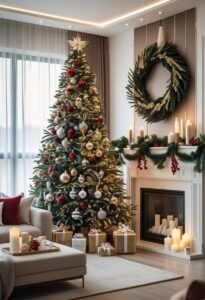Introduction
Wainscoting is a classic interior design feature that adds elegance, charm, and character to any home. Whether you’re refreshing a single room or redesigning an entire space, wainscoting offers a versatile and stylish solution.
This decorative wall paneling has been a favorite for centuries, and its popularity continues to grow in modern homes.
In this article, we’ll explore what wainscoting is, its history, types, benefits, installation tips, and how it can elevate your living space.
What Is Wainscoting?

Wainscoting refers to wooden paneling that covers the lower portion of a wall, typically extending from the floor to about one-third or halfway up. Originally designed to protect walls from damage, it has evolved into a decorative element that enhances the aesthetic appeal of interiors.
Wainscoting can be made from various materials, including wood, MDF (medium-density fiberboard), PVC, or even tile, and comes in a range of styles to suit different tastes.
This wall treatment is often found in dining rooms, hallways, bathrooms, and living rooms, but its versatility makes it suitable for any space. From traditional raised panels to sleek, modern designs, wainscoting adds texture and visual interest while creating a polished look.
A Brief History of Wainscoting

Wainscoting has a rich history that dates back to the 16th century in Europe. Initially, it served a practical purpose—insulating homes and protecting walls from moisture, scuffs, and wear. Wealthy homeowners used intricately carved oak panels to showcase their status, particularly in grand estates and castles.
By the 18th and 19th centuries, wainscoting became more accessible as woodworking techniques improved. It was a staple in Georgian and Victorian homes, where it added warmth and sophistication to interiors. Today, wainscoting remains a popular choice for homeowners who want to blend historical charm with modern functionality.
Types of Wainscoting Styles
Wainscoting comes in a variety of styles, each offering a unique look and feel. Here are some of the most popular types:
1. Raised Panel Wainscoting
- Description: Features panels with beveled edges that “raise” above the surrounding frame, creating a three-dimensional effect.
- Best For: Formal spaces like dining rooms or libraries.
- Aesthetic: Elegant and traditional, perfect for classic or luxurious interiors.
2. Flat Panel (Recessed) Wainscoting
- Description: Panels are flat and recessed within the frame, offering a sleek and understated look.
- Best For: Modern or transitional homes.
- Aesthetic: Clean and minimalist, ideal for contemporary spaces.
3. Beadboard Wainscoting
- Description: Consists of vertical planks with small ridges or “beads” between them, giving a cottage-like charm.
- Best For: Kitchens, bathrooms, or cozy spaces.
- Aesthetic: Casual and inviting, often associated with farmhouse or coastal styles.
4. Board and Batten Wainscoting
- Description: Features wide vertical boards separated by narrow battens, creating a rustic or architectural look.
- Best For: Entryways, mudrooms, or modern farmhouses.
- Aesthetic: Bold and textured, great for adding visual height to a room.
5. Shiplap Wainscoting
- Description: Horizontal planks with slight gaps, popularized by farmhouse-style interiors.
- Best For: Living rooms or bedrooms seeking a relaxed vibe.
- Aesthetic: Warm and approachable, with a touch of rustic charm.
Each style of wainscoting can be customized with paint, stain, or unique molding to match your home’s decor.
Benefits of Installing Wainscoting
Wainscoting offers both aesthetic and practical advantages, making it a worthwhile investment for homeowners. Here are some key benefits:
- Enhances Visual Appeal: Wainscoting adds depth and texture to walls, transforming plain surfaces into focal points.
- Protects Walls: It shields lower walls from scratches, dents, and scuffs, especially in high-traffic areas like hallways or kids’ rooms.
- Increases Home Value: Quality wainscoting can boost your home’s resale value by adding a premium, custom look.
- Versatile Design: Available in various styles and materials, wainscoting complements any interior design, from traditional to modern.
- Easy Maintenance: Most wainscoting materials are durable and easy to clean, requiring only occasional dusting or wiping.
According to a 2023 survey by the National Association of Home Builders, 68% of homebuyers prefer homes with custom architectural details like wainscoting, highlighting its appeal in the real estate market.
Where to Use Wainscoting in Your Home
Wainscoting is incredibly versatile and can enhance nearly any room. Here are some ideas for incorporating it into your home:
Dining Rooms
Wainscoting creates a sophisticated backdrop for formal dining spaces. Pair raised panel wainscoting with a bold wall color above for a dramatic effect.
Bathrooms
Beadboard wainscoting adds a spa-like feel to bathrooms. Use moisture-resistant materials like PVC to prevent water damage.
Hallways and Entryways
Board and batten wainscoting can make narrow hallways feel taller and more inviting. It’s also durable enough to withstand daily wear.
Bedrooms
Shiplap wainscoting behind a headboard adds a cozy, textured accent to bedrooms. Paint it in soft neutrals for a calming atmosphere.
Home Offices
Flat panel wainscoting brings a professional yet warm vibe to home offices, perfect for creating a focused workspace.
Choosing the Right Material for Wainscoting
The material you choose for wainscoting affects its durability, cost, and appearance. Here’s a breakdown of common options:
| Material | Pros | Cons | Best For |
| Solid Wood | Authentic, durable, customizable | Expensive, prone to warping | High-end, traditional homes |
| MDF | Affordable, easy to paint | Less durable, sensitive to moisture | Budget-friendly projects |
| PVC | Waterproof, low maintenance | Less authentic look | Bathrooms, basements |
| Tile | Elegant, water-resistant | Costly, harder to install | Kitchens, bathrooms |
For most homeowners, MDF is a popular choice due to its affordability and versatility. However, if you’re aiming for a luxurious look, solid wood wainscoting is unmatched in quality.
How to Install Wainscoting: A Step-by-Step Guide
Installing wainscoting can be a DIY project for those with basic carpentry skills, or you can hire a professional for a flawless finish. Here’s a simplified guide to installing beadboard wainscoting:
- Measure and Plan:
- Measure the height and length of the walls to determine how much material you’ll need.
- Decide on the height of the wainscoting (typically 36–48 inches).
- Mark the wall with a level to ensure straight lines.
- Gather Materials:
- Purchase beadboard panels, baseboard, chair rail, adhesive, and nails.
- Tools needed: saw, level, measuring tape, stud finder, and caulk gun.
- Prepare the Wall:
- Remove existing baseboards and clean the wall.
- Locate and mark wall studs for secure panel attachment.
- Cut and Install Panels:
- Cut beadboard panels to the desired height.
- Apply construction adhesive to the back of each panel and press it onto the wall.
- Secure panels with finishing nails into the studs.
- Add Trim:
- Install baseboard at the bottom and chair rail at the top to frame the wainscoting.
- Use wood filler to cover nail holes and seams.
- Finish:
- Sand any rough edges and apply caulk to gaps.
- Prime and paint or stain the wainscoting for a polished look.
For a standard 10×12-foot room, expect to spend $500–$1,500 on materials and tools for a DIY wainscoting project, depending on the material chosen.
Painting and Finishing Wainscoting
The finish you choose for your wainscoting can dramatically impact the room’s vibe. Here are some tips:
- Classic White: White wainscoting creates a crisp, timeless look that pairs well with any wall color.
- Two-Tone Effect: Paint the wainscoting a darker shade than the upper wall for contrast.
- Natural Wood Stain: Highlight the grain of solid wood wainscoting with a stain for a warm, organic feel.
- Bold Colors: Use deep hues like navy or emerald green for a modern, statement-making look.
Always use high-quality, semi-gloss or satin paint for wainscoting, as these finishes are durable and easy to clean.
Wainscoting Design Ideas to Inspire You
Need inspiration? Here are some creative ways to use wainscoting:
- Accent Wall: Install wainscoting on a single wall to create a focal point, such as behind a bed or dining table.
- Full-Height Wainscoting: Extend wainscoting to the ceiling for a dramatic, library-like effect.
- Mix and Match: Combine beadboard wainscoting with wallpaper above for a playful, eclectic look.
- Curved Details: Use custom-cut wainscoting to follow the curve of a staircase or arched doorway.
Common Mistakes to Avoid
While wainscoting is relatively straightforward to install, here are some pitfalls to watch out for:
- Incorrect Measurements: Always double-check measurements to avoid uneven panels or gaps.
- Skipping Primer: Failing to prime MDF or wood can lead to paint absorption and an uneven finish.
- Ignoring Moisture: Use waterproof materials like PVC in bathrooms to prevent mold and warping.
- Overloading Design: Too much wainscoting in a small room can feel overwhelming; balance it with simple decor.
How Much Does Wainscoting Cost?
The cost of wainscoting depends on materials, labor, and the size of the project. Here’s a rough estimate:
- Materials: $2–$15 per square foot (MDF is cheaper; solid wood or tile is pricier).
- Labor: $50–$100 per hour for professional installation.
- Total Cost: A 12×12-foot room with MDF beadboard wainscoting might cost $800–$2,000, including labor.
For budget-conscious homeowners, DIY installation and affordable materials like MDF can keep costs down.
Maintaining Your Wainscoting
Wainscoting is low-maintenance, but proper care ensures it stays beautiful for years:
- Cleaning: Dust regularly and wipe with a damp cloth to remove smudges.
- Touch-Ups: Repaint or restain every 5–10 years to refresh the look.
- Repairs: Fix dents or scratches with wood filler and sandpaper before repainting.
Conclusion
Wainscoting is more than just a wall covering—it’s a design statement that brings warmth, character, and durability to your home. Whether you prefer the timeless elegance of raised panels or the cozy charm of beadboard, wainscoting offers endless possibilities to personalize your space.
With its rich history, versatile styles, and practical benefits, it’s no wonder wainscoting remains a favorite among homeowners and designers alike.
Ready to transform your walls? Consider wainscoting for a project that combines beauty and functionality. With careful planning and the right materials, you can create a stunning interior that stands the test of time.






More Stories
How To Style A Coffee Table For Every Home
How to Decorate Your Home for Christmas Like a Pro
15 Easy Steps to Build a DIY Pergola: A Complete Homeowner’s Guide